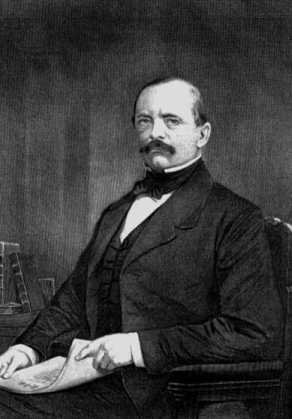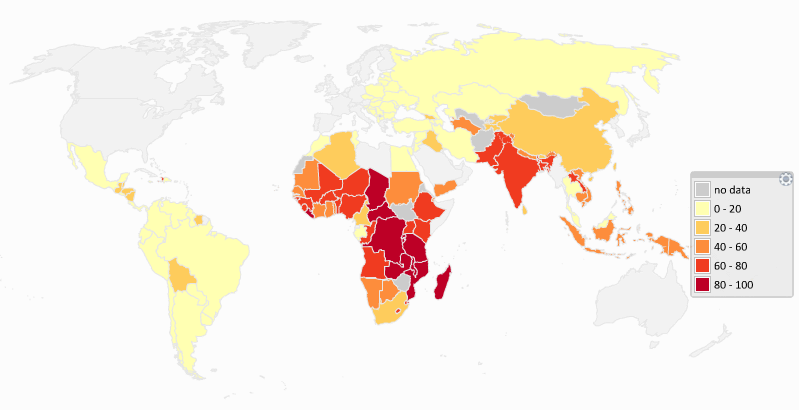
Otto von Bismarck.
An introduction to Social Policy

The idea of the "welfare state" means different things in different countries.
This section of the website is mainly concerned with the provision of welfare in different countries. If you would like to read more on the idea of the "welfare state", including arguments for and against welfare provision, you should begin with the section on social policy.
Deborah Mitchell [1] identifies five main approaches to the comparison of welfare systems:
Further material: Models
of
welfare
Several texts try to generalise about the experience of several countries. Common themes in the historical literature include:
Further material: The development of UK social policy, 1601-1948
Asa Briggs, in a classic essay on the British welfare state, identified three principal elements. These were
This has become identified with the 'institutional' model of welfare. The key elements of institutional welfare are social protection, and the provision of welfare services on the basis of right.
In practice, social welfare in the United Kingdom is very
different
from this ideal. Coverage is extensive, but benefits and services are
delivered at a low level. The social protection provided is patchy, and
services are tightly rationed. Esping-Andersen [4] classifies the
UK welfare state along with restrictive 'liberal' regimes such as
the USA.
Further material: Social Policy in the UK

Otto von Bismarck.
The post-war German settlement was based on the idea of a 'social state', sometimes rendered as a 'social market economy'. The first, central principle was that economic development was the best way to achieve social welfare. The structure of social services had to reflect this priority. The principle is represented most clearly in the close relationship of services to people's position in the labour market. Social benefits are earnings-related, and those without work records may find they are not covered for important contingencies. Less clear, but probably even more important, is the general concern to ensure that public expenditure on welfare is directly compatible with the need for economic development and growth.
Second, the German economy, and the welfare system, developed through a corporatist structure. This principle was developed by Bismarck on the basis of existing mutual aid associations, and remained the basis for social protection subsequently. Social insurance, which covers the costs of health, some social care and much of the income maintenance system, is managed by a system of independent funds.
Third, there is a strong emphasis on the principle of "subsidiarity". This principle is taken in Germany to mean both that services should be decentralised or independently managed, and that the level of state intervention should be residual - that is, limited to circumstances which are not adequately covered in other ways. Higher earners are not covered by the main social insurance system, but are left to make their own arrangements.
External link: The OECD on Germany | Links to German sites (in German)
Unemployment insurance in France is based on a 'convention' or collective agreement between employers and trades unions, not on legislation. The system is run by Unédic, not by the French government
Social protection in France is based on the principle of solidarity: the commitment is declared in the first article of the French Code of Social Security. The principle is used in a number of different senses. The idea seems, at first sight, to refer to co-operative mutual support. Some writers apply the term in relation to 'mutualist' groups (friendly societies) and emphasise that people insured within national schemes (les assurés sociaux) are called to contribute and benefit on an equal footing. Others stress that relationships of solidarity are based in interdependence. Solidarity is usually understood, in this context, in terms of common action, mutual responsibility and shared risks.
The pursuit of 'national solidarity' was undertaken in the first place by attempting progressively to extend the scope of existing solidarities, most notably through the creation of a 'régime général' for health and social security, and subsequently through its progressive expansion. Since the 1970s this pattern of solidarities has been supplemented by 'insertion' or social inclusion, designed to bring 'excluded' people into the net. The most important of these measures was the Revenu Minimum d'Insertion (RMI), introduced in 1988, which combines a basic benefit with a personal contract for 'insertion' or social inclusion. This has become increasingly identified with participation in the labour market, and in 2011 the RMI was replaced by the Revenu de Solidarité Active, which is intended to put more stress on the individual responsibility of unemployed people.
The French system of welfare is a complex, patchwork quilt of services. This kind of arrangement is relatively expensive, and much of the focus of social policy in recent years has fallen on the control of expenditure - filling 'the hole in the social', le trou de la Sécu. The main areas of concern are not dependency or unemployment, but pensions, because of the special privileges accorded to particular occupational groups, and spending on health care, where the stress on independent, market-led services (la médicine libérale) presents considerable problems in cost control.
External link: The OECD on France
External link: The OECD on Poland
Titmuss's 'institutional-redistributive' model combines the principles of comprehensive social provision with egalitarianism. This is an "ideal type", rather than a description of reality. Social protection is not necessarily associated with equality; the French and German systems offer differential protection according to one's position in the labour market. The Swedish system, looked at in greater detail, has many of the same characteristics: Ringen describes the system as "selective by occupational experience". [6] However, the importance of equality - sometimes identified with 'solidarity', in the sense of organised co-operation - is considerable. The model of this is the 'solidaristic wage policy' advocated by the labour movement, which emphasised improving standards, limited differentials, and redistribution.
External links: The OECD on Sweden | Swedish Social Democrats: "Our principles and values" (PDF)

Poster for
the 1935 Social
Security scheme:
from the FDR
Library.
The United States is sometimes described as a ‘liberal' welfare regime, in the sense that it represents individualism, laissez-faire, residualism and a punitive view of poverty. These issues often seem to dominate US debates on welfare: examples are the introduction of 'workfare', the exclusion of long-term benefit dependents, and the criticism of the 'underclass'.
The US does not, however, have a unified welfare system. Federalism has meant that many important functions are held by the States, including public assistance, social care and various health schemes (Hawaii has had mandatory health insurance and a state-funded health system since the 1970s); recent reforms of health care have reinforced that diversity. By comparison with other developed countries, central government has had a limited role in social welfare provision: the main developments of federal provision were during the Roosevelt administration of the 1930s, which laid the foundations for the social security system, and the "War on Poverty" of the 1960s, which provided some important benefits (notably health care for people on low incomes) and engaged the federal government in a wide variety of projects and activities at local level.
In practice, the US is pluralistic rather than liberal. There are significant departures from the residual model - e.g. state schooling, social insurance, or services for military personnel, veterans and their families, which together provide for more than 72 million people. In addition to federal and state activity, there are extensive private, mutualist and corporate interests in welfare provision. The resulting systems are complex: the guiding principle is less one of consistent individualism than what Klass has called "decentralised social altruism". [7] Diversity and complexity come at a price, and despite - or perhaps because of - political hostility to welfare provision, the US system is also unusually expensive.
External links: US
government agencies | History
of US social security | Mirror, Mirror - US Health Care compared
The provision of social protection in China is a mix of incomplete systems: they include social assistance, partial social insurance and welfare services. Social insurance varies by occupation and location. Social assistance offers a Minimum Livelihood Guarantee (dibao). In principle, dibao extends throughout urban China, but in practice its operation and administration vary locally. There has been some extension to rural areas, but there are still gaps. The provision of welfare is localised and often inconsistent and liable to subversion through mismanagement, corruption or simply being ignored.
"There is not one welfare state", Ringen and Ngok argue, "but many and radically different ones". [8] In South East Asia there are several states which have been described as 'developmental', giving priority to economic development through strong state intervention. In the authors' view, China does not fit the pattern well. Social protection has been introduced unevenly and late; there is no consistent pattern; the pattern of development has been restricted and conservative, rather than being taken as an instrumental aspect of development. They describe the system as fragmented, "limited and defensive in both ambition and practice."
India has a large population (now over 1.2 billion people) in very diverse circumstances. The major obstacles to extending the welfare state are excessive reliance on agriculture, informal labour economy and low levels of employment in the service sector. Large sections of the workforce have precarious access to bank accounts or insurance schemes. In the decades after independence, attempts to expand social security coverage across the population were marred by clientelism and political patronage of favoured ethnic and caste groups. [9]
Social policy in India has been dominated by a plethora of social protection programmes. [10] Several of these programmes were initiated recently, or received additional impetus. The programmes include:
However, social policies in India are largely residual,
with strict
mean-testing procedures and with little potential to create productive
assets in terms of human capital formation and public goods.The
majority of citizens still
largely
rely on family, kinship and community for welfare activities.
[11]
The European Community was founded for political and economic reasons. The central political aim was less European Union than the maintenance of peace in Europe. The principal economic aim was the establishment of a European free market. By contrast, there were no clear social aims; such social measures as there were followed from the pressures of economic policy. During the 1970s, the emphasis of Community social policy changed towards improving 'living and working conditions' in the community, and the idea of the 'worker' was extended to include those who were not part of the labour force. Once it was accepted that the Community had social objectives distinct from the economic objectives, it became possible to expand the role of the Community in social policy.
The powers of the Union have developed through incremental development of marginal, relatively innocuous measures in order to establish precedent and competence. For example, provisions covering cigarette packets, bus passes or language teaching sought to establish competence in relation to public health, old people, transport and education. This has been resisted through the idea of 'subsidiarity', by which action should always be taken at the lowest possible level.
The Commission's approach to the development of policy is based on the incremental development of services, the progressive expansion of solidarity, and the insertion of those who are excluded. Powers have been taken to deal with the problems of exclusion.
External links: The European Union | The EU and social protection

World Bank: % of populations on less than $2 a day
Economic development is essential to welfare. It produces material goods. It promotes integration and interdependence, and extends people's entitlements. It has clearly beneficial effects on social welfare: the last 30-40 years have seen spectacular improvements in longevity, infant survival, access to basic amenities like water supplies and fuel, and the provision of services like health care and education. At the same time, development produces casualties. It makes poor people vulnerable; it uproots traditional lifestyles; it can lead to social polarisation. The 'structural adjustment' favoured by international organisations - moving developing countries towards a formal market economy - has been criticised for pushing developing countries into a situation where their poor will be unprotected.
Although economic development is fundamental, it does not guarantee social protection. Traditional social security tended to be confined to narrowly defined occupational groups. Increasing numbers of low and middle income countries have introduced social protection schemes - since 2000, the coverage in lower income countries has gone from less than 100m people to over 840 million.
External links: Poverty and development | The Sustainable Development Goals | Video - Hans Rosling on progress in dealing with poverty | Manchester University - Social Assistance Explorer
Further reading: Poverty
The development of a global economy has implications for national welfare policies. The nation state is being 'hollowed out', with power being dispersed to localities, independent organisations, and supra-national bodies (like NAFTA or the European Union). Mishra argues, in Globalization and the Welfare State, that globalization limits the capacity of nation-states to act for social protection. Global trends have been associated with a strong neo-liberal ideology, promoting inequality and representing social protection as the source of 'rigidity' in the labour market. International organisations like the World Bank and International Monetary Fund have been selling a particular brand of economic and social policy to developing countries, and the countries of Eastern Europe, focused on limited government expenditure, selective social services and private provision. [13]
This case is perhaps overstated. It is true that there has
been
retrenchment in many countries, and an increased focus on selective
social services. At the same time, most developed countries have moved
towards general coverage of the costs of hospital care, and more
inclusive social protection policies. Transitional economies are moving
in a similar direction, and the mushroom growth of social assistance
schemes (often in the form of Conditional Cash Transfers) is
particularly remarkable. There has been a greater
diversification of the basis of coverage, through a combination of
governmental and non-governmental provisions. There is no consistent
trend to greater inequality, though Piketty argues that increasing
inequality is unavoidable. [14]
Further reading
C Pierson, Beyond the welfare state?, Polity 2006
G Esping-Andersen, The three worlds of welfare capitalism, Polity 1990
R Goodin, B Headey, R Muffels, H-J Dirven, The real worlds of welfare
capitalism, Cambridge University Press 2000.
J Clasen (ed) Comparative social policy: concepts, theories and
methods, Blackwell 1999
P Kennett (ed) A handbook of comparative social policy, Cheltenham:
Edward Elgar 2004
D Garland, The welfare state: a very short introduction, Oxford: Oxford
University Press 2016
P Spicker, States and welfare states, Policy Press 2022